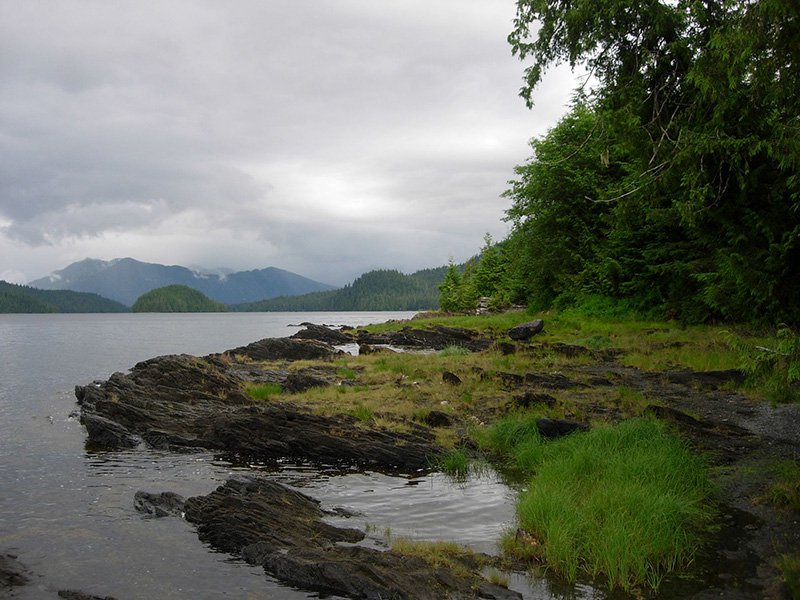A changing climate is altering rain and snowfall patterns that affect the waters Alaska salmon call home, for better or worse. A first-of-its-kind study now details the potential changes for Southeast Alaska, and how people can plan ahead to protect the fish.
One third of Alaska’s salmon harvest each year comes from fish produced in the 17,000 miles of streams in the Tongass National Forest. Creative Commons photo by Mark Brennan.One third of Alaska’s salmon harvest each year comes from fish produced in the 17,000 miles of streams in the Tongass rainforest. More than 50 species of animals feed on spawning salmon there, and one in 10 jobs is supported by salmon throughout the region.
“Global climate change may become one of the most pressing challenges to Pacific Salmon conservation and management for Southeast Alaska in the 21st Century” begins a report called “Climate Change Sensitivity Index for Pacific Salmon Habitat in Southeast Alaska” by Colin Shanley and David Albert of The Nature Conservancy.
“In general, the global climate models are saying the wetter places in the world are likely to get wetter and the dryer places are going to get dryer,” said Shanley, who works as a conservation planner and GIS analyst in Juneau.
“This is not a doom-and-gloom outlook,” Shanley stressed. “This is really just getting smarter about how climate change may play out and how it might affect resources that are valuable to us.”
Shanley studied nearly a half century’s records of 41 water gauge stations at Southeast watersheds to model future projections on how flow patterns might change. He said watersheds fed by snow packs will likely experience the biggest impacts.
“Some of the watersheds that are super steep and fed by snow driven catchments are going to see some of the biggest changes. They might not all be bad, but those are the ones that showed some of the largest changes in flow,” he said.
On the other hand, glacial fed waters could provide new and better salmon systems.
“In Southeast, South-central and Prince William Sound there are a lot of glacial fed systems that salmon use and some that salmon haven’t colonized yet. As glaciers shrink and melt, there is some opportunity to create new, and in some cases, better habitat,” he explained. “Some of those glacial systems are really big rivers, so there are definitely opportunities for some shifts in productivity.”
Watersheds that are in good shape should be fairly resilient, Shanley said. For waters adjacent to roads and culverts that have changed historically, the Conservancy plans to do restoration projects, such as making sure there is adequate drainages and adding trees and stumps.
“The wood slows down the water so that can help with higher water levels, and it also provides pools and shade and protection from predators,” Shanley said.
More new research by the Oregon-based Wild Salmon Center (WSC) also provides a glimpse of how a flooded future could hurt salmon in Southeast and other Alaska regions.
Salmon spawn in streams in the fall and eggs develop through the winter, so increased winter flooding could potentially scour their eggs from stream beds and harm the next generations of fish, said WSC science director Matthew Sloat.
 Pink salmon. U.S. Forest Service photo by Joe Serio.In collaboration with the U.S. Forest Service, Sloat modeled the possible flood disturbances on coho, chum and pink salmon spawning habitats in over 800 Southeast watersheds.
Pink salmon. U.S. Forest Service photo by Joe Serio.In collaboration with the U.S. Forest Service, Sloat modeled the possible flood disturbances on coho, chum and pink salmon spawning habitats in over 800 Southeast watersheds.
They found that as much as 16 percent of the spawning habitat for coho salmon could be lost by the 2080s primarily in narrower, steeper streams. The effects were lower for pink and chum salmon, which spawn almost exclusively in low sloping floodplain streams.
Somewhat surprisingly, the study shows that the overall risk of flood impacts to salmon reproduction in Southeast Alaska appears much lower than previously thought. That’s due to the relatively pristine condition of the area's rivers and floodplains, according to Sloat.
"Flood plains act as pressure release valves that can dissipate the energy of large floods," he said. "Our results identify key parts of watersheds that, if protected, will continue to buffer salmon populations from flood disturbance in the future.”







.jpg.small.400x400.jpg)